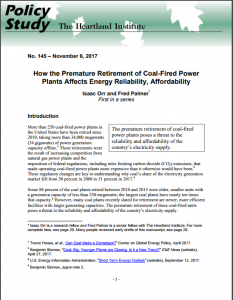Full Title: How the Premature Retirement of Coal-Fired Power Plants Affects Energy Reliability, Affordability
Author(s): Isaac Orr and Fred Palmer
Publisher(s): The Heartland Institute
Publication Date: November 1, 2017
Full Text: Download Resource
Description (excerpt):
More than 250 coal-fired power plants in the United States have been retired since 2010, taking more than 34,000 megawatts (34 gigawatts) of power generation capacity offline.1 These retirements were the result of increasing competition from natural gas power plants and the imposition of federal regulations, including rules limiting carbon dioxide (CO2) emissions, that made operating coal-fired power plants more expensive than it otherwise would have been.2 These regulatory changes are key to understanding why coal’s share of the electricity generation market fell from 50 percent in 2008 to 31 percent in 2017.
Some 88 percent of the coal plants retired between 2010 and 2015 were older, smaller units with a generation capacity of less than 250 megawatts; the largest coal plants have nearly ten times that capacity.4 However, many coal plants recently slated for retirement are newer, more efficient facilities with larger generating capacities. The premature retirement of these coal-fired units poses a threat to the reliability and affordability of the country’s electricity supply.
